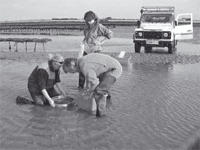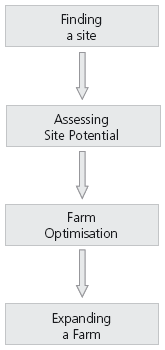Background
European marine aquaculture is expanding rapidly, bringing societal benefits to coastal areas where traditional employment opportunities are declining. Total European aquaculture production has increased by approximately 40% in each of the last two decades. In 2002 the European Commission recognised the need to address the sustainability of this industry. The Common Fisheries Policy, which covers European aquaculture developments, recognises that the way forward to a sustainable industry is through an ecosystem based approach, ‘where the integrated management of land, water and living resources must promote the conservation and sustainable use of marine resources in an equitable way’ An ecosystem approach to aquaculture management is not about managing or manipulating ecosystems but is concerned with ensuring aquaculture management decisions do not adversely affect ecosystem function and productivity and so marine resource use is sustainable in the long term.
One of the main objectives of the EU strategy for sustainable aquaculture is to ensure an environmentally sound industry and develop specific criteria and guidelines for Environmental Impact Assessments of aquaculture developments. The focus of the ECASA project is to provide industry and regulators with tested tools and methods for assessing assimilative capacity and for predicting ecosystem effects in an environment forced by economic and climatic variability.
Project
ECASA- An Ecosystem Approach for Sustainable Aquaculture – is a Framework 6 RTD project, coordinated by the Scottish Association for Marine Science, Oban, Scotland (www.ecasa.org.uk). ECASA involves 16 research partners from 13 EU member states.
The objectives of the ECASA project are to:
- Identify quantitative and qualitative indicators of the effects of aquaculture on the environment and vice-versa, and to assess their applicability
- Assess and develop operational tools, including models, to establish and describe the relationship between environmental conditions and aquaculture activities over a range of ecosystems and aquaculture production systems
- Develop effective environmental impact assessment and site selection methods for coastal area management

The indicators of the main drivers of ecosystem change were identified and assessed, and their applicability was tested throughout Europe during the summer 2006 field campaign. Thirteen different study sites from 9 European countries were involved in the ECASA field campaign representing an array of environmental conditions and cultivated species: from a Norwegian site north of the Arctic Circle, ranging south to a Greek site located on the Isle of Crete. Both fin-fish and shellfish production systems were included in the study.
The environmental models developed throughout the ECASA project are capable of examining the relationship between the environment and aquaculture activities. These models will help inform regulatory decisions on aquaculture, establish appropriate monitoring programmes and improve husbandry practices to optimise productivity in a sustainable way.
The Toolbox

The main outcomes of the ECASA project are presented in a virtual ‘Tool-Box’ containing a suite of indicators and predictive environmental models whose focus will be to aid the assessment of appropriate sites for aquaculture activities and then subsequently provide a consistent framework for the application of Environmental Impact Assessments, resulting in coherent and relevant Environmental Statements. Trials with the various tools that have been studied have been carried out at a range of fish and shellfish farms across Europe and these case studies are presented in the ‘Tool-Box’ in the format of an Environmental Statement.
This ‘Tool-Box’ gives advice on:
- the merits of the chosen indicator set including best methodologies for collection, analysis and interpretation
- the recommended set of models, including criteria for choice of models depending on spatial scale and farm size
- the use of models to estimate site and water body assimilative capacity and sustainable production
- the reliability of model predictions
The site is set up to be intuitive and points the various user groups to where they will most rapidly reach the required information. For example, as a shellfish farmer the home page presents a logical flow of information designed to guide the user.
Each of the boxes in the figure are linked to explanatory text, models appropriate to specific culture types, and environmental indicators that can be used for modelling, together with case studies.
Indicators
The production of indicators is a fast developing activity in both environmental and economic studies. The starting point began after the Rio conference in 1992, when awareness of worldwide environmental degradation became widespread. At the same time, the conditions needed to achieve sustainable development had to consider the complexity of the different systems involved, including ecosystems. To allow laymen to understand the idea, and the information related to the concept of sustainable development, it was proposed to build simple measurements of complex entities; these measurements were identified as Indicators. The concept was almost as successful as that of sustainable development, and the production of various indicators sharply increased in many different areas. Now the use of indicators is recognized as an efficient tool of communication for the wider audience, particularly in the field of sustainability.
During the course of ECASA, large numbers of indicators were proposed for use in the future application of Environmental Impact assessments. Many were tested in the field at various sites representing the range of conditions under which European marine aquaculture is practiced today. The Toolbox has sections devoted to indicators dealing with sediment, benthos, water quality, socioeconomic and others.
Models
Indicators and models are two kinds of tools in the Toolbox, but their objectives are quite different. Indicators measure the actual status of the environment before, during or after an event such as the start of the aquaculture growing cycle. However, the relationship between the event and the indicator requires scrutiny, which is one of the reasons why several indicators should be used to describe the impact of aquaculture on the marine environment. Indicators cannot predict any future environmental conditions, as models do. In the context of an EIA, indicators serve as a reference status or as a signal for environmental change (qualitative or quantitative) and form the basis of a monitoring programme.
Models however, can predict future conditions without any further measurements since they have been validated and field tested before use. Models are increasingly more flexible and precise, mainly due to increasing computer power, but their quality depends on the models underlying processes and validation of results through a large range of environmental conditions.
Using both indicators and models greatly increases the ability of scientists, regulators, producers and environmental consultants to carefully assess the potential impact of new aquaculture operations, or the expansion of existing sites, to characterize and evaluate any actual impact, and to define areas where the impact of marine aquaculture could minimized. Some sixteen models were studied during the ECASA project and these are listed, with full details, on the toolbox website (see link below).
Conclusion
We hope that the ECASA project will bring a useful set of tools to the attention of a wide stakeholder group and that as a result, aquaculture is able to expand with the optimum balance between low environmental impact and high socio-economic benefits.
Further information
For more information on the evolution of the ECASA project visit http://www.ecasa.org.uk. The Toolbox may be accessed from http://www.ecasatoolbox.org.uk
July 2008

